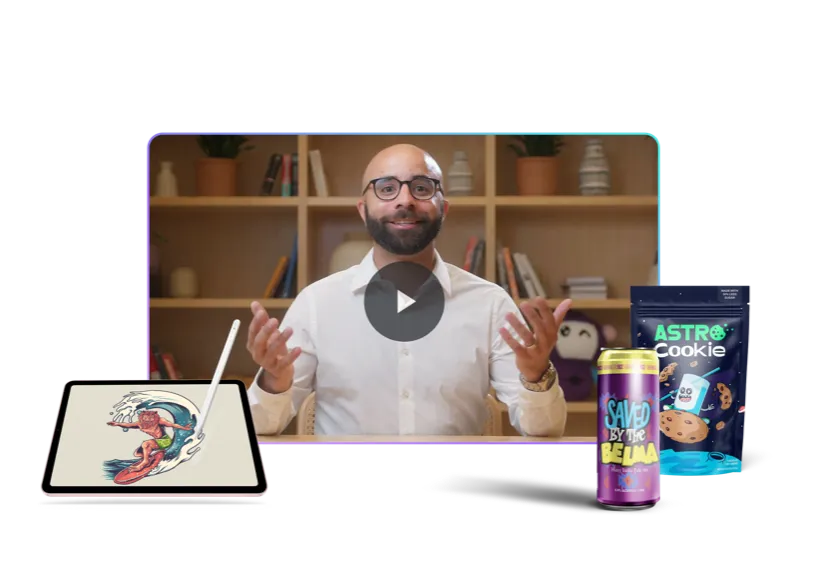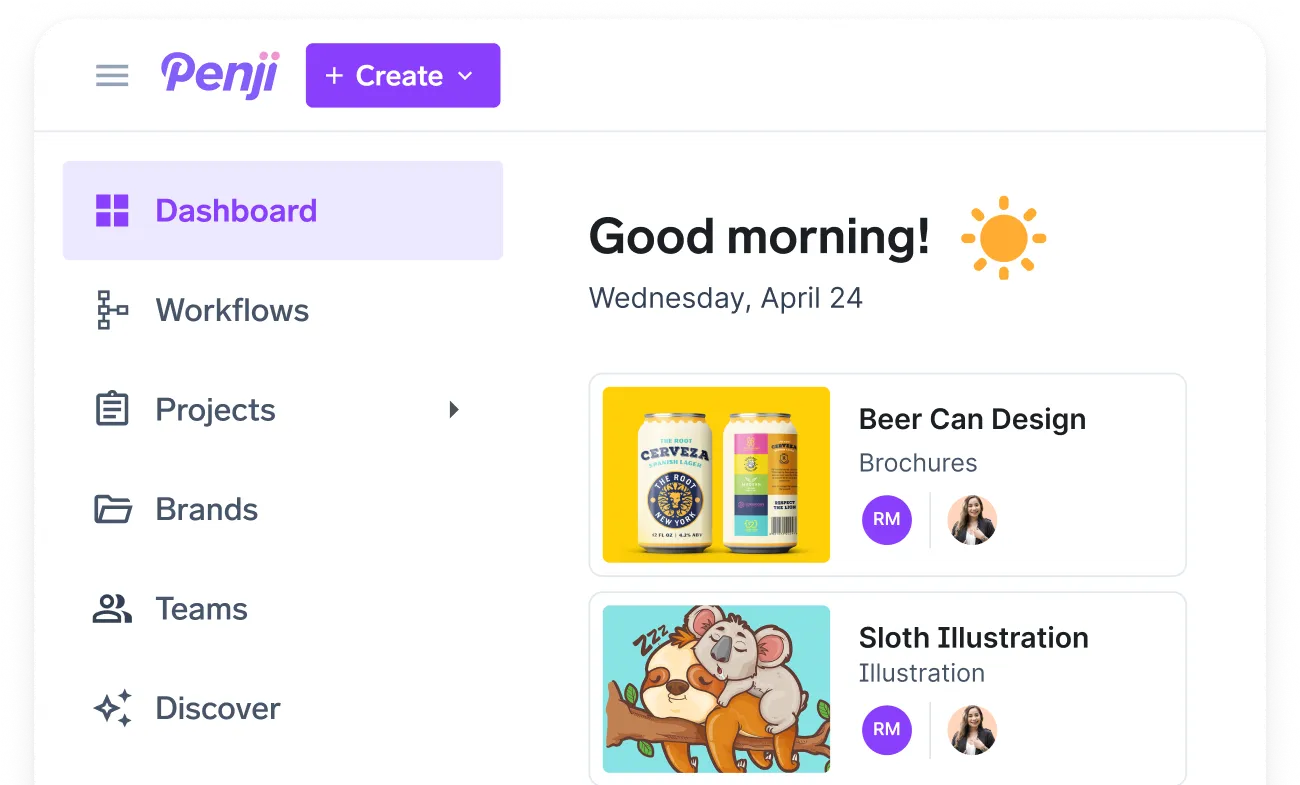![[Fully Managed] Phil Wiseman from Analytics That Profit Ep. 132](https://penji.co/wp-content/uploads/2025/07/BLOG-IMAGE-Phil-Wiseman.jpg)
[Fully Managed] Phil Wiseman from Analytics That Profit Ep. 132
Introduction and Background
Shannon Donnelly (SD): Alrighty. Hello, everyone, and welcome to the Fully Managed by Penji podcast, the podcast where we discuss marketing and business tips to help assist you on your business journey. I’m your host, Shannon, Penji’s Partnership Coordinator, and I’m joined here today with a very special guest, Phil Wiseman from Analytics That Profit. Thank you so much for coming on with me today.
Phil Wiseman (PW): Shannon, great to be here.
SD: I appreciate that. Thank you so much. So could you just start by telling us a little bit about yourself? You can tell us a fun fact—it doesn’t have to be professionally related—but something that shows who you are, and what inspired you to create this agency and led you to this point in your career?
PW: So, fun fact is I actually do have a degree in chemical physics.
SD: I saw that.
PW: And I’m also a drummer.
SD: So you’re an all-rounded individual.
PW: You would think that has nothing to do with marketing, but long story short, I had an industrial wastewater treatment business for decades, sold that business, and a friend of a friend had a business and said, “Hey, I could use some help with sales.” I’ve always enjoyed salespeople, so as I started working with them, I thought, “We should update the website.” I didn’t know anything about websites. Then I thought, “We should probably run those Google Ads people are talking about.” So we started doing that, and I realized I didn’t really know what any of it meant.
I hired an agency to tell me what the agencies were doing, and every month I’d get those reports—likes, clicks, impressions, shares, reach—and I thought, “Guys, that’s not helpful. I’ve got a voice here. How many times did they click the ad and then put in an RFQ?” I just wasn’t getting the answers. I complained to a friend, and they said, “Google Analytics answers all those questions.” I’d never heard of Google Analytics.
So I became a Google Partner, got all these Google Analytics certifications, and realized I could answer those questions. I fired all the agencies, rebuilt the website, quit Google Ads, started producing content. One night I was talking to a friend and said, “Man, I figured out all these cool things about websites and marketing.” He said, “You should start your own business and teach other business owners how to do this.” I thought everyone else had it all figured out.
So I started Analytics That Profit about ten years ago as a side hustle. I had sold that one business and didn’t really need to work, but I found so many small business owners had the same questions I had. I always hear the same thing: “I’m spending money on…”—and they fill in the blank—”but I don’t know if it’s working.” I love working with small business owners and being educational. If you don’t understand something, don’t buy it.
So many business owners think, “I need SEO,” and they buy it without knowing what they’re buying. Or, “I need marketing or I should run ads,” but they don’t understand it. They don’t have a defined outcome. They end up spending all this money not knowing what the results should be. It’s like the emperor’s clothes: “Oh, you should have this,” and they spend money without knowing what it is. So that’s the whole focus behind Analytics That Profit—educating business owners to make informed decisions. And of course, being the nerd with a chemical physics degree, I love measuring things.
SD: Perfect. I think that’s really helpful to have found a space that needed help. A lot of agencies hop on something because they’re experienced in that field, and that’s fine. But it’s nice to find something new and realize there’s a problem. I was actually curious—did you create this agency as a reaction to what you were seeing? Because a lot of your language reflects that: people are wasting money and time doing things that don’t yield results. Clicks, impressions, and likes are important—maybe—but if they’re not getting you any money, then it doesn’t matter.
PW: I like to alternatively define marketing terms. Impressions are how many people ignored you.
SD: I love that.
PW: I came into this wanting a one-time engagement—just to help a business owner understand how to use Google Analytics and connect the dots. But I’ve had customers from day one. I don’t do contracts or retainers. Everything is month to month, and some clients have been with me for over nine years.
I feel the pressure should be on the agency to produce results. You shouldn’t feel constrained by a contract and hear, “Give it three more months,” or, “Let’s try this.” I like defined outcomes and clear objectives—so we know where we’re going, why, and what success looks like.
Defining Clear Goals and Processes
SD: No, I completely understand that. And I like that you’re able to lay that out for them because I think that provides an extensive level of transparency to your clients and potential clients. A lot of people go to agencies and get shown clicks, likes, impressions—and that might look good—but those metrics are supposed to lead to what everyone’s actually looking for: sales and active service use. If they aren’t translating, what’s the point?
PW: I agree. It’s cool that we’ve filled that need because I don’t see it very often. Most agencies offer the typical package. And that’s fine—they might actually be doing what I do and just not advertising it. But I have a very specific goal: do what other agencies say they’ll do, but with evidence beyond just impressions.
With the technology we have now, you can measure almost everything. It’s called a pixel—a little piece of script. Even if you’re running an over-the-top ad and someone clicks on it, you can track back all these different sources: advertising, referral, channels. And that helps you go, “Oh yeah, this brought us traffic.” Then take it further: “This is connecting with our ideal customer,” and we’re getting more leads and closing more business from that specific channel. Guess what? Spend more there and drop the rest.
SD: I think a lot of people struggle with knowing where to focus their time or money. They want to be well-rounded, which is fine, but sometimes, if something’s working—do more of that. There are risks in marketing. Sometimes all the eggs in one basket is the best move.
PW: I agree. A hundred percent.
Why Process Matters in Results
SD: So how—maybe this is too general—but how do you guarantee these things when you advertise? Is it just statistics? Is it the tracking systems? What sets you apart from agencies doing similar work?
PW: Like I said, I’m a nerd. I used to teach quality management and I’m very process-driven. I have a process for everything I do. I tell people that upfront: I have a process, and we won’t deviate. That’s not up for debate.
The first step is my onboarding questionnaire. I ask the right questions: What searches do you want to show up for? Who is your ideal client? I love when people say, “Everyone is our ideal client.” That’s just not true.
The problem with most marketing is that it’s not hyper-specific. You mentioned my website—people say it’s rough or abrasive. That’s intentional. My ideal client is a business owner who’s tired of BS. They read it and say, “He gets me.” They see their exact problem being called out.
It’s about honing in: What do you want to show up for on search? Who is your ideal customer? And the most overlooked piece—every business gets asked the same five questions all the time. I always say: write about those problems, your solution, and how they can do business with you.
SD: Yes, I’ve been to so many websites that give you info but don’t have an easy “order now” or “schedule a call” option. Or they make you click through a bunch of steps or use some quirky calculator. It’s too much.
PW: Exactly. Frictionless. Everything they need in three clicks. I focus a lot on user experience and also SEO. People treat SEO like magic—it’s not. It’s just listening to your customer, answering their questions, and measuring the effect.
Building Trust and Transparency
SD: Do you ever run into issues with clients not being transparent? Maybe they think they should be doing one thing, but you realize that’s not going to help them long-term?
PW: That’s a big part of any business relationship—trust. When you meet someone for the first time, they’ve only moved so far down the trust funnel. You have to build that trust over time so they feel comfortable being honest. A lot of them have been burned before—worked with someone who oversold and underdelivered—so they keep their cards close to their chest.
My personality helps. I’m blunt and to the point, and people pick up on that pretty quickly. What you see is what you get. That kind of candor builds rapport, and then they’ll open up. I had someone tell me they spent $12,000 with a company and had no idea what they got. That’s terrible.
SD: That is horrible. I think sometimes people aren’t even afraid of doing business—it’s just embarrassment. They’re not doing as well as they’d like, and even though they’re asking for help, there’s pride involved. It’s hard for business owners to admit that.
PW: Especially for owners who built their business from the ground up. Maybe it started with them and a family member, and now they have 10, 20, 30 employees. It’s deeply personal.
What I try to explain is that you—the owner—are not scalable. You can’t clone yourself. So you need processes that are repeatable and scalable. Some people call them playbooks. I call them processes. Same thing. Write down what works, how you do it, and train others to follow it. That’s how you grow.
Back when I was running a quality-certified company, I used to say, “You can change the process, but you can’t fix people.” Most people want to do their best. If you give them a good process, they can succeed. If it’s not working, change the process—not the person.
SD: That’s so true. People get stuck when they hit a certain number of employees or revenue, and they don’t know what to do next. Sometimes they haven’t even asked themselves why customers buy from them and not someone else.
PW: Yes! I ask that exact question on my onboarding form. Why do people choose you over your competitors? Most of them haven’t asked their own customers that.
It’s important to talk to your customers. Why did they choose you? Why are they still with you? What do they love about working with you? You’ll learn a lot from those answers.
Listening and Learning from Clients
SD: I think it’s really important to have that ongoing communication. Not just to get compliments—which are always nice—but also criticism. Fair criticism helps you grow. Sometimes it’s too much to ask, but sometimes it’s actionable. And even the bad relationships teach you something.
PW: Absolutely. But don’t send a twenty-question survey. Pick up the phone and talk to them.
SD: Right. And regarding relationships—like you said—the opposite of love isn’t hate. It’s ambivalence. People may hate you but still use your product because it works. But once they stop caring? That’s when it’s over.
PW: Exactly. Ambivalence is the killer. You want to stay connected. That ongoing feedback helps you keep improving and keeps the relationship alive.
Reviews, Referrals, and the Power of Feedback
SD: It’s hard sometimes not to get overly absorbed in negative feedback—especially if you’re already critical of your own business. But balancing that with fair, honest evaluation is key. It’s crazy how many business owners don’t consistently consider what their customers feel about the process, not just the results.
PW: You can have a service that yields good results, sure. But if the process is horrible—if no one enjoys working with you—it’s still not a good experience. And that’s going to impact referrals and reviews.
Most agencies rely heavily on referrals. And you’re right: people won’t refer you if they didn’t like the experience. They have to have an outstanding experience to even bother writing a review. People would rather do anything else with their time—unless they hated it.
SD: Oh, yeah. People are definitely more motivated to write a bad review than a good one. If their experience was average, they’ll just stay quiet.
PW: Exactly. When we’re mad, we want to yell. But when things go well, we rarely say anything unless we’re asked.
That’s why you have to ask for reviews. You can’t just assume people will leave one. Send a follow-up email: “Hey, tell us what you think. Click here to leave a review.” And you might have to send it more than once—because people get a hundred emails a day. And sometimes they just ignore you.
SD: I actually take every survey after a customer service call—especially from insurance or banking—because I know how much those impact performance reviews. Being in this industry, I get it.
But yeah, for agencies, it’s all about trust. People aren’t just referring you because you did an okay job. They’re staking their own reputation on your performance. If I refer someone, it means I trust them to do right by that person.
PW: Absolutely. It’s the same with referring someone to a job. If you vouch for them and they’re a nightmare, that reflects on you.
I worked in restaurants before, and I’ve seen someone say, “Oh, my friend needs a job.” And that person lasted a month. I was like, “Guys, I’m so sorry.”
SD: That’s why they needed a job—because they’re not good at it! You don’t want to refer someone average. You want to refer someone who’s a pleasure to work with and does excellent work. That’s what earns referrals.
Website Personality and Client Fit
SD: I wanted to ask about your website. I think it’s really fun. You swear, you call yourself a nerd—it has personality. Do you think that helps you attract the kind of clients you actually want to work with?
PW: Absolutely. I have a friend who’s great at building buyer personas. Years ago, I worked with her to dial in my site. It’s evolved over time, but yeah—that’s my personality. I have a personalized license plate that says “NERD.” Another one says “DRUMMER.”
I learned a long time ago: I want to chase away the people who aren’t a good fit. My ideal client should read my site and say, “He gets me.” Someone who’s ready to get serious. If you don’t like the bluntness, then go with a traditional agency. I’m not for you.
SD: I love that. It shows you respect yourself and your time. And it makes work more enjoyable. Of course, when you’re starting out, you don’t always get to be choosy. But at a sustainable point, it’s ideal to work with people you like and who appreciate what you bring.
PW: Yep. Earlier in my career, I couldn’t always be picky. But now I’m in a unique spot—I don’t have to work with anyone I don’t want to.
When I was running my water treatment company, I developed something called the “PIA premium.” You’re probably wondering what that stands for—Pain In the Ass. Certain clients were extra difficult. I’d upcharge them 20% and literally put “PIA: 20%” on the invoice.
One engineer once asked, “What’s this PIA?” I said, “Mark, you’re a pain in the ass to work with.” But they had their own processes, forms, spreadsheets—it was extra work. I didn’t mind doing it, but I compensated myself for it.
SD: That’s hilarious—and fair! Honestly, people should adopt that mentality. If someone takes more time and energy, why wouldn’t you charge more? You’re not cheapening yourself, and you’re not working for free.
Pricing Confidence and Closing Thoughts
PW: Exactly. And if they don’t value you enough to pay more, they’re probably going to leave for someone cheaper anyway.
SD: I love that mentality. And I think more people should adopt it. Of course, when you’re starting out, you don’t always have the luxury. But the goal is to get to a place where you do.
PW: Right. I used to work with a lot of startups, showing them how to use Google Analytics, Search Console, all that. They’d land a big opportunity with a name-brand player and immediately talk about offering a discount. I’d say, “Oh no, no. You need to raise your prices.”
Their expectations are higher. It’s more work. One woman I worked with—brilliant chemical engineer—was severely underselling herself. I finally convinced her to double her prices. When she did, her clients said, “We were wondering what took you so long.” Because she was good.
SD: That’s amazing. And it’s true—sometimes underselling yourself backfires. Not only are you losing money, but people might see your low price and assume you’re not good. They think, “Why is this so cheap?”
PW: Exactly. In my case, my standard fees are still less than what the big-box firms charge. But there’s a reason. I’ve been using AI, machine learning, language models for a long time. I’ve built tools to get results fast. So I don’t need hours and hours.
The time I save on data analysis, I put into thinking. That’s where the real value is—strategizing based on the data. I know what I want to make per hour. That’s how I price. I’m not going to charge more just because I know someone else does.
SD: That’s respectable. You’re not taking advantage of clients just because others do. You know your worth and you price accordingly. That’s rare—and refreshing.
PW: There’s an old expression in sales: “Pigs get fat, hogs get slaughtered.”
SD: I love that. I’m definitely going to use that one. My boyfriend’s from upstate Pennsylvania and always says the weirdest things. I’m going to tell him I grew up with that one.
Final Thoughts and Farewell
SD: Well, this is all the time we have today, which is very unfortunate. We didn’t get to the game, but that’s okay because we had such a great conversation.
I really appreciate you coming on with me today, Phil. I learned a lot—and that’s always my number one goal. But it was also just a fun time, so thank you.
PW: It’s been my pleasure. I’m so happy you invited me.
SD: Thank you so much. And everyone who’s listening or watching, don’t forget to like and subscribe to see more stories like this. I appreciate you coming on, Phil. And thank you again.
PW: Thank you.
https://www.analyticsthatprofit.com
About the author
Table of Contents
- Introduction and Background
- Defining Clear Goals and Processes
- Why Process Matters in Results
- Building Trust and Transparency
- Listening and Learning from Clients
- Reviews, Referrals, and the Power of Feedback
- Website Personality and Client Fit
- Pricing Confidence and Closing Thoughts
- Final Thoughts and Farewell









